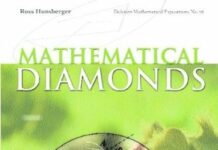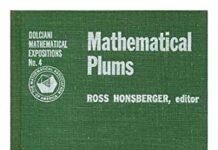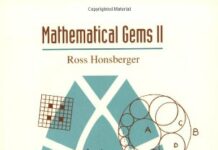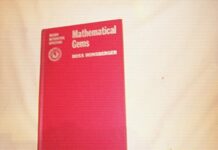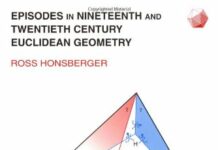
Ebook Info
- Published: 1998
- Number of pages: 216 pages
- Format: PDF
- File Size: 10.52 MB
- Authors: Ross Honsberger
Description
The nineteen essays here illustrate many different aspects of mathematical thinking. The author is very well-known for his best-selling books of problems; in this volume he seeks to share his appreciation of the elegant and ingenious approaches used in thinking about even elementary mathematics. Standard high school courses in algebra and geometry furnish a sufficient basis for understanding each essay. Topics include number theory, geometry, combinatorics, logic and probability, and the methods used often involve an interaction between these disciplines. Some of the essays are easy to read, others more challenging; some of the exercises are routine, others lead the reader deeper into the subject.
User’s Reviews
Editorial Reviews: Book Description Essays illustrating ingenuity and elegance used to solve problems in mathematics; high school maths required. Book Description The nineteen essays here illustrate many different aspects of mathematical thinking. The author is very well-known for his best-selling books of problems; in this volume he seeks to share his appreciation of the elegant and ingenious approaches used in thinking about even elementary mathematics.
Reviews from Amazon users which were colected at the time this book was published on the website:
⭐Very creative methods to solve problems
⭐Great book! Had some ideas that were very clever and original to me.
⭐As the Note to the reader recites, this book was written in order to make important mathematical ideas “interesting and understandable” to a larger audience than mere professionals. Inspired by Rademacher and Toplitz’s masterpiece “the enjoyment of mathematics” and by the publications appeared in the memorable journal “Scripta Mathematica”, Honsberger aims to provide examples that show the “incisiveness” and “ingenuity” of first-rate or less known mathematical results, that have all astounded him. This is not an easy task, especially if one wants to achieve all this without excessive technicalities. The result is however satisfactory. Honsberger collects 19 essays on miscellaneous topics loosely related one to other except for the fact of giving the reader an insight into incisive and ingenious mathematical work.In order to have a better grasp of these qualities, I shall briefly survey the essay 15 on Mascheroni’s and Steiner’s results on geometric constructions. A first issue discussed by Honsberger is a beautiful question of elementary geometry: What problems can we solve if we use only the compass and we dispose of the ruler? Before answering this question, that was the subject of a book published by Mascheroni in 1797, Honsberger enters an instructive discussion on the equivalence of geometric instruments. For instance, we learn in the book that it can be proved in an elementary way that the collapsible compass (namely the compass which collapses when either arms are lifted from the paper) can effectuate the same constructions as the divider, i.e. the compass which can mark distances. Then Honsberger goes on to give a simplified proof of Mascheroni’s major result: “any construction which can be carried out with straightedge and compass can be carried out with compass alone”. Honsberger surveys three ways in which points can be determined in the Euclidean plane: either as i) intersections between two circles, ii) or intersections between a straight line and a circle, or iii) as intersections between straight lines. He then proves that cases ii) and iii) can be obtained solely with the compass and without effectively tracing straight lines by means of the straightedge.Secondly, Honsbergers expounds the so-called Poncelet-Steiner’s theorem (“any construction that can be executed with straightedge and compasses can be carried out with straightedge alone, provided that just one circle and its centre is given”) with an analogous strategy, by showing that if a point is determined using straightedge and compass it can be determined exactly with the restrictions prescribed by Steiner.Other chapters (but not the one one Mascheroni and Steiner) are also enriched with exercises, whose solutions can be found at the end of the book.
⭐This is a marvellous volume for math enthusiasts of all ages and levels. It’s accessible to an inquisitive high school student with little background in the subject; and it doesn’t duplicate the sort of material found in high school and university courses, so it’s still got plenty to offer the graduate student or math teacher. The author’s enthusiasm for the subject leaps out from every paragraph, and it’s contagious. Honsberger carefully and thoroughly explains the proofs he presents; very little of import is left to the reader. Among the results:- If x and y are positive numbers less than 1, chosen at random, the probability that x, y, and 1 form the sides of an obtuse triangle is (pi-2)/4- For any string of digits S=a_1a_2…a_m, and integer n not a power of 10, there is a power of n that begins with the string S- On average, the probability that two randomly chosen integers are coprime is 6/pi^2.At the end of each section are practice problems that make use of the material just presented, and these offer additional insight into the scope of the proofs.In short, it’s a great book, and it’s particularly helpful for high school students looking for practice on contest-type problems, and for teachers looking for material for gifted students.
Keywords
Free Download Ingenuity in Mathematics (Anneli Lax New Mathematical Library, Series Number 23) in PDF format
Ingenuity in Mathematics (Anneli Lax New Mathematical Library, Series Number 23) PDF Free Download
Download Ingenuity in Mathematics (Anneli Lax New Mathematical Library, Series Number 23) 1998 PDF Free
Ingenuity in Mathematics (Anneli Lax New Mathematical Library, Series Number 23) 1998 PDF Free Download
Download Ingenuity in Mathematics (Anneli Lax New Mathematical Library, Series Number 23) PDF
Free Download Ebook Ingenuity in Mathematics (Anneli Lax New Mathematical Library, Series Number 23)
